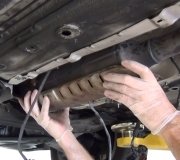Hi cherie826 and welcome to 2carpros
how do you know if your catalytic converter is bad?
The catalytic converter is our main line of defense against air pollution, so it's important to make sure it is functioning efficiently and passing exhaust without creating undue restrictions that might reduce performance, fuel economy or emissions. That's one of the reasons for periodic vehicle emissions testing. If the converter isn't working, you won't pass the test.
If the your converter is plugged, it will create a restriction in your exhaust system. The buildup of backpressure will cause a drastic drop in engine performance and fuel economy, and may even cause the engine to stall after it starts if the blockage is severe.
The easiest test for converter plugging is done with a vacuum gauge. Connect the gauge to a source of intake vacuum on the intake manifold, carburetor or throttle body. Note the reading at idle, then raise and hold engine speed at 2,500. The needle will drop when you first open the throttle, but should then rise and stabilize. If the vacuum reading starts to drop, pressure may be backing up in the exhaust system.
You can also try to measure backpressure directly. If your engine has air injection, disconnect the check valve from the distribution manifold, and connect a low pressure gauge. Or, remove the oxygen sensor and take your reading at its hole in the manifold or headpipe. Refer to the backpressure specs for the application. Generally speaking, more than 1.25 psi of backpressure at idle, or more than 3 psi at 2,000 rpm tells you there's an exhaust restriction.
If there appears to be an exhaust restriction, disconnect the exhaust pipe just aft of the converter to relieve pressure and recheck the readings. CAUTION: The pipes will be hot so wait awhile for things to cool down. If vacuum goes up and/or backpressure drops, the problem isn't not a plugged converter but a plugged muffler or collapsed pipe. If there's little or no change in readings, the converter is plugged.
Just because a converter is passing gas doesn't mean it is okay. If the catalyst inside is contaminated or worn out, high carbon monoxide (CO) and/or hydrocarbon (HC) readings will be present in the exhaust. If you have access to a high temperature digital pyrometer (or an oven thermometer will do), check the converter's temperature fore and aft. A good converter will usually run 100 degrees F hotter at its outlet than its inlet. Little or no temperature change would indicate low efficiency, or a problem with the converter's air supply. Converters need supplemental oxygen in the exhaust to reburn pollutants, so if the air injection system or aspirator valve isn't doing its job the converter can't do its job either.
SPONSORED LINKS
Tuesday, October 28th, 2008 AT 6:55 PM




